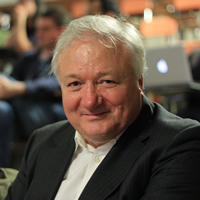
Cosmology and astrophysics are in some ways the most grandly abstract of sciences, not only because they deal with the ultimate questions—how did the universe begin and how will it eventually end?—but also because, in addressing those questions, they confront time and distance at their deepest levels. Throughout more than four decades, Rashid Sunyaev has been asking those ultimate questions, wrestling with their profound implications, and leading generations of scientists to a deeper understanding of the birth, life, and ultimate fate of our universe.
Born in 1943 in Uzbekistan, Sunyaev studied at the Moscow Institute of Physics and Technology and went on to obtain his doctorate from Moscow University under the mentorship of the noted Russian astrophysicist Yakov Zeldovich. He first made his scientific mark in a series of papers in collaboration with Zeldovich on galaxy formation and the nature of the cosmic microwave background (CMB) radiation. When the CMB was confirmed in 1965, it provided firm evidence to support Big Bang Theory, proving to be the "echo" of the formation of the universe. While at first the CMB was thought to be completely the same in all directions, Sunyaev and Zeldovich were among the first to predict the existence of slight fluctuations in the CMB spectrum that could provide insight into the accretion of matter and subsequent formation of galaxies in the universe's early history. These fluctuations were later detected, just as Sunyaev and Zeldovich had predicted, by NASA's COBE satellite, as well as other ground- and space-based observations.
From this work, the two scientists eventually proposed what came to be known as the Sunyaev-Zeldovich or SZ effect, in which the CMB radiation is distorted by electron scattering in clusters of galaxies. When the initial paper on the SZ effect was published, it seemed more of theoretical than practical interest, because the phenomena it predicted were believed to be almost too subtle to detect. But the development of more sensitive and sophisticated observational technologies, including space-based instruments, have transformed the SZ effect from a theoretical curiosity into a powerful tool for the detection and characterization of galaxy clusters and the Hubble constant of the expansion of the universe. Once again, Sunyaev's ideas had been proven as observational technology caught up with the range and daring of his theoretical work.
If these contributions had not already secured Rashid Sunyaev's place as one of the world's leading astrophysicists, that status would undoubtedly be assured by his 1973 paper (with N.I. Shakura) on the physics of accretion disks, which has become one of the most cited scientific papers of all time. This seminal work continues to serve as the standard model for how matter accretes and flows inward toward a rapidly rotating object such as a black hole or neutron star. Sunyaev expanded upon this work to study how such objects also generate huge amounts of x-rays and gamma rays, providing a foundation upon which much subsequent research in x-ray and gamma ray astronomy has been based.
Sunyaev's career displays a remarkable breadth of interests, encompassing everything from the origins of the universe itself to the small-scale workings of astronomical phenomena such as black holes and x-ray sources. His active participation as a scientist on various space missions such as the Planck, GRANAT, INTEGRAL, and Spectrum X spacecraft, as well as his close involvement with ground-based astronomical resources including the Atacama Cosmology Telescope, demonstrate that he is equally at home with the hard edge of experimental science as with the abstractions of theoretical work. Currently he serves as the director of the Max Planck Institute for Astrophysics in Munich, Germany, as well as Chief Scientist at the Russian Academy of Sciences Space Research Institute. He is the recipient of numerous international scientific awards and accolades, including the Gold Medal of the Royal Astronomical Society, the Crafoord Prize in Astronomy from the Royal Swedish Academy of Sciences, the Henry Norris Russell Award from the American Astronautical Society, and the Order of Merit of the Federal Republic of Germany.
Information as of April 2012

